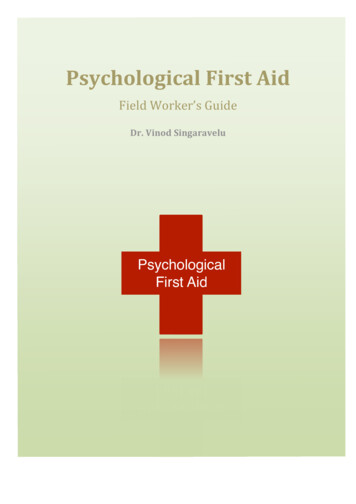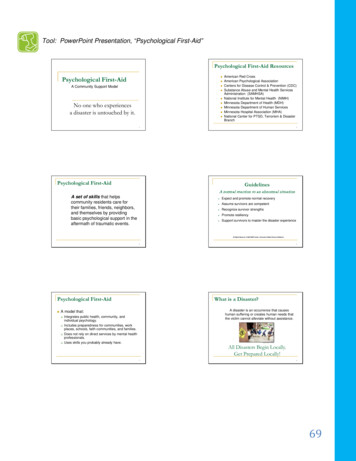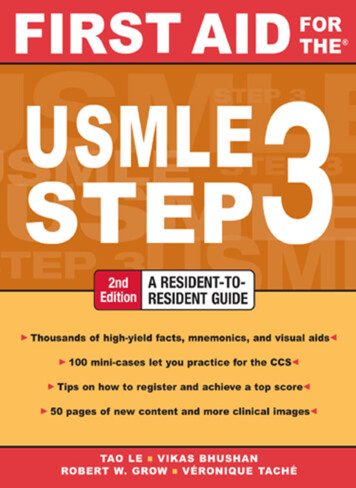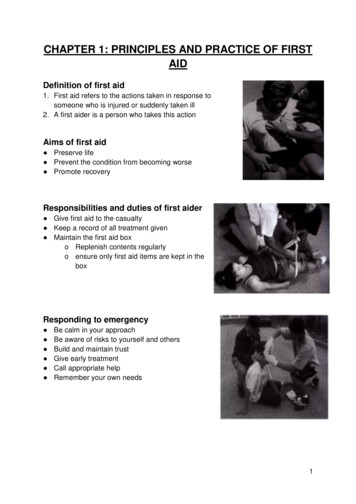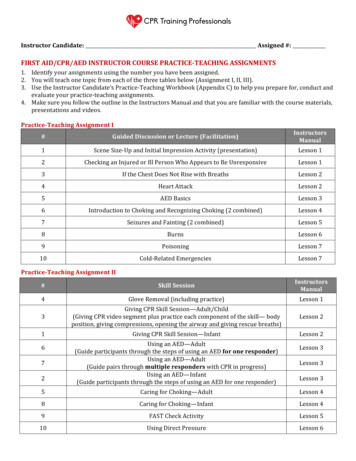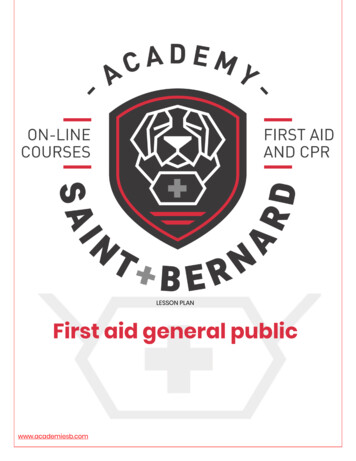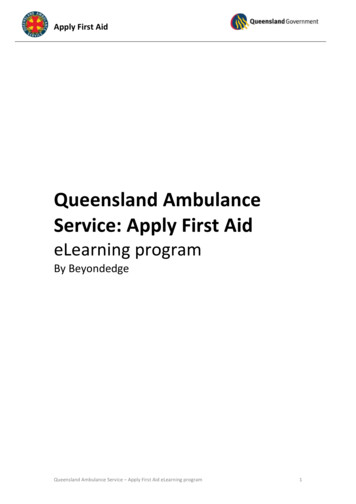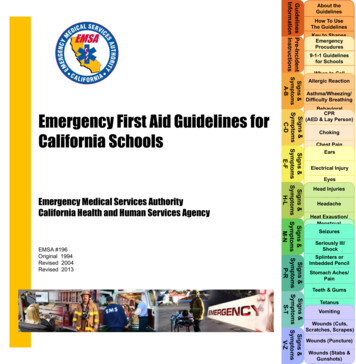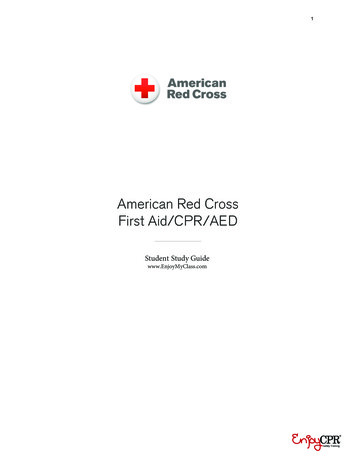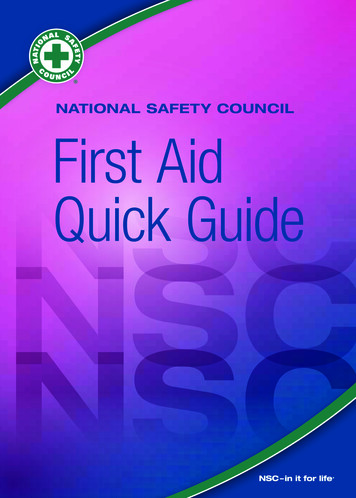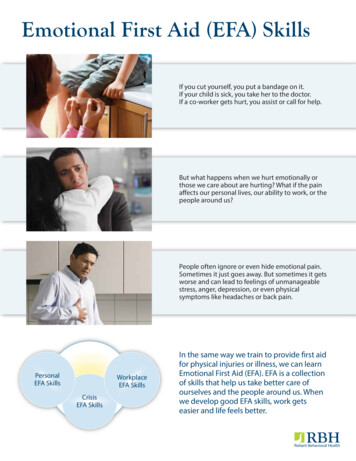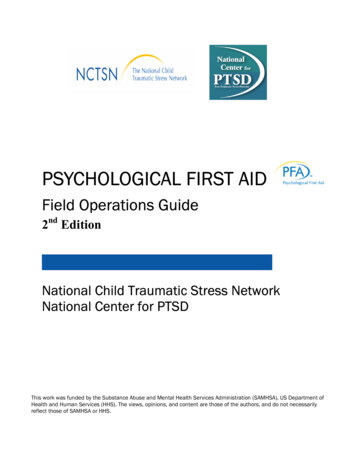
Transcription
PSYCHOLOGICAL FIRST AIDField Operations Guide2nd EditionNational Child Traumatic Stress NetworkNational Center for PTSDThis work was funded by the Substance Abuse and Mental Health Services Administration (SAMHSA), US Department ofHealth and Human Services (HHS). The views, opinions, and content are those of the authors, and do not necessarilyreflect those of SAMHSA or HHS.
AcknowledgementsThis Psychological First Aid Field Operations Guide was developed by the National ChildTraumatic Stress Network and the National Center for PTSD. Members of the National ChildTraumatic Stress Network and the National Center for PTSD, as well as other individualsinvolved in coordinating and participating in disaster response, contributed to the currentdocument.The principal authors (in alphabetical order) include: Melissa Brymer, Anne Jacobs, ChrisLayne, Robert Pynoos, Josef Ruzek, Alan Steinberg, Eric Vernberg, and Patricia Watson.Special contributors (in alphabetical order) include: Steve Berkowitz, Dora Black, CarrieEpstein, Julian Ford, Laura Gibson, Robin Gurwitch, Jessica Hamblen, Jack Herrmann, RussellJones, Robert Macy, Betty Pfefferbaum, Rose Pfefferbaum, Beverly Raphael, Margaret Samuels,William Saltzman, Merritt Schreiber, Janine Shelby, Cynthia Whitham, Bonita Wirth, RuthWraith, and Bruce Young.Additional material for this Psychological First Aid Field Operations Guide was drawn from anadaptation by the Medical Reserve Corps (MRC). Principal authors for the MRC adaptation (inalphabetical order) include: Abbe Finn, Jack Herrmann, John Hickey, Edward Kantor, PatriciaSantucci, and James Shultz. Additional content was provided by members of the ClergyAdaptation Group, including from Fuller Theological Seminary (in alphabetical order): DavidAugsburger, Cynthia Eriksson, David Foy, Peter Kung, Doug McConnell, Kathy Putnam, DaveScott, and Jennifer van Heijzen; from North Shore Long Island Jewish Health System andHealthCare Chaplaincy (in alphabetical order): Christine DiBenedetto, Nathan Goldberg, GeorgeHandzo, Yusuf Hasan, Martha Jacobs, Sandra Kaplan, Victor Labruna, Jon Overvold, DavidPelcovitz, Ayme Turnbull, Juliet Vogel, and Eun Joo Kim. Additional content was also providedby the University of California, San Francisco (in alphabetical order): Chandra Ghosh Ippen,Alicia Lieberman, and Patricia Van Horn.A SAMHSA-supported expert review panel convened on March 31-April 1, 2005, whereparticipants made invaluable contributions. Those attending (in alphabetical order) included:Miksha Brown, Cecilia Revera-Casale, Kerry Crawford, Rosemary Creeden, Daniel Dodgen,Darrin Donato, William Eisenberg, Mary Fetchet, Ellen Gerrity, Richard Gist, Ian Gordon, SusanHamilton, Seth Hassett, Jack Herrmann, Stevan Hobfoll, Stacia Jepson, Sandra Kaplan, SusanKo, Linda Ligenza, Steven Marans, Christina Mosser, April Naturale, Elana Newman, BonnieO’Neill, Dori Reissman, Gilbert Reyes, Janine Shelby, and Robert Ursano.For citation: National Child Traumatic Stress Network and National Center for PTSD,Psychological First Aid: Field Operations Guide, 2nd Edition. July, 2006. Available on:www.nctsn.org and www.ncptsd.va.gov.ii
Psychological First AidTABLE OF CONTENTSIntroduction and Overview1Preparing to Deliver Psychological First Aid6Core Actions91. Contact and Engagement102. Safety and Comfort123. Stabilization284. Information Gathering: Current Needs and Concerns325. Practical Assistance376. Connection with Social Supports397. Information on Coping448. Linkage with Collaborative Services55List of AppendicesAppendix A: Overview of Psychological First AidAppendix B: Service Delivery Sites and SettingsAppendix C: Psychological First Aid Provider CareAppendix D: Psychological First Aid WorksheetsAppendix E: Handouts for Survivors585961647072iii
Introduction and OverviewINTRODUCTION AND OVERVIEWWhat is Psychological First Aid?Psychological First Aid is an evidence-informed1 modular approach to help children,adolescents, adults, and families in the immediate aftermath of disaster and terrorism.Psychological First Aid is designed to reduce the initial distress caused by traumatic events andto foster short- and long-term adaptive functioning and coping. Principles and techniques ofPsychological First Aid meet four basic standards. They are: (1) consistent with researchevidence on risk and resilience following trauma; (2) applicable and practical in field settings;(3) appropriate for developmental levels across the lifespan; and (4) culturally informed anddelivered in a flexible manner. Psychological First Aid does not assume that all survivors willdevelop severe mental health problems or long-term difficulties in recovery. Instead, it is basedon an understanding that disaster survivors and others affected by such events will experience abroad range of early reactions (for example, physical, psychological, behavioral, spiritual). Someof these reactions will cause enough distress to interfere with adaptive coping, and recovery maybe helped by support from compassionate and caring disaster responders.Who is Psychological First Aid For?Psychological First Aid intervention strategies are intended for use with children, adolescents,parents/caretakers, families, and adults exposed to disaster or terrorism. Psychological First Aidcan also be provided to first responders and other disaster relief workers.Who Delivers Psychological First Aid?Psychological First Aid is designed for delivery by mental health and other disaster responseworkers who provide early assistance to affected children, families, and adults as part of anorganized disaster response effort. These providers may be imbedded in a variety of responseunits, including first responder teams, incident command systems, primary and emergency healthcare, school crisis response teams, faith-based organizations, Community Emergency ResponseTeams (CERT), Medical Reserve Corps, the Citizens Corps, and other disaster relieforganizations.When Should Psychological First Aid Be Used?Psychological First Aid is a supportive intervention for use in the immediate aftermath ofdisasters and terrorism.1Psychological First Aid is supported by disaster mental health experts as the “acute intervention of choice” whenresponding to the psychosocial needs of children, adults and families affected by disaster and terrorism. At the timeof this writing, this model requires systematic empirical support; however, because many of the components havebeen guided by research, there is consensus among experts that these components provide effective ways to helpsurvivors manage post-disaster distress and adversities, and to identify those who may require additional services.1
Introduction and OverviewWhere Should Psychological First Aid Be Used?Psychological First Aid is designed for delivery in diverse settings. Mental health and otherdisaster response workers may be called upon to provide Psychological First Aid in generalpopulation shelters, special needs shelters, field hospitals and medical triage areas, acute carefacilities (for example, Emergency Departments), staging areas or respite centers for firstresponders or other relief workers, emergency operations centers, crisis hotlines or phone banks,feeding locations, disaster assistance service centers, family reception and assistance centers,homes, businesses, and other community settings. For more information on the challenges ofproviding Psychological First Aid in various service settings, see Appendix B.Strengths of Psychological First Aid Psychological First Aid includes basic information-gathering techniques to help providersmake rapid assessments of survivors’ immediate concerns and needs, and to implementsupportive activities in a flexible manner.Psychological First Aid relies on field-tested, evidence-informed strategies that can beprovided in a variety of disaster settings.Psychological First Aid emphasizes developmentally and culturally appropriateinterventions for survivors of various ages and backgrounds.Psychological First Aid includes handouts that provide important information for youth,adults, and families for their use over the course of recovery.Basic Objectives of Psychological First Aid Establish a human connection in a non-intrusive, compassionate manner.Enhance immediate and ongoing safety, and provide physical and emotional comfort.Calm and orient emotionally-overwhelmed or distraught survivors.Help survivors to tell you specifically what their immediate needs and concerns are, andgather additional information as appropriate.Offer practical assistance and information to help survivors address their immediate needsand concerns.Connect survivors as soon as possible to social support networks, including familymembers, friends, neighbors, and community helping resources.Support adaptive coping, acknowledge coping efforts and strengths, and empowersurvivors; encourage adults, children, and families to take an active role in their recovery.Provide information that may help survivors cope effectively with the psychological impactof disasters.Be clear about your availability, and (when appropriate) linking the survivor to anothermember of a disaster response team or to local recovery systems, mental health services,public-sector services, and organizations.2
Introduction and OverviewDelivering Psychological First AidProfessional Behavior Operate only within the framework of an authorized disaster response system.Model healthy responses; be calm, courteous, organized, and helpful.Be visible and available.Maintain confidentiality as appropriate.Remain within the scope of your expertise and your designated role.Make appropriate referrals when additional expertise is needed or requested by thesurvivor.Be knowledgeable and sensitive to issues of culture and diversity.Pay attention to your own emotional and physical reactions, and practice self-care.Guidelines for Delivering Psychological First Aid Politely observe first, don’t intrude. Then ask simple respectful questions to determine howyou may help.Often, the best way to make contact is to provide practical assistance (food, water,blankets).Initiate contact only after you have observed the situation and the person or family, andhave determined that contact is not likely to be intrusive or disruptive.Be prepared that survivors will either avoid you or flood you with contact.Speak calmly. Be patient, responsive, and sensitive.Speak slowly, in simple concrete terms; don’t use acronyms or jargon.If survivors want to talk, be prepared to listen. When you listen, focus on hearing what theywant to tell you, and how you can be of help.Acknowledge the positive features of what the survivor has done to keep safe.Give information that directly addresses the survivor’s immediate goals and clarify answersrepeatedly as needed.Give information that is accurate and age-appropriate for your audience.When communicating through a translator or interpreter, look at and talk to the person youare addressing, not at the translator or interpreter.Remember that the goal of Psychological First Aid is to reduce distress, assist with currentneeds, and promote adaptive functioning, not to elicit details of traumatic experiences andlosses.Some Behaviors to Avoid Do not make assumptions about what survivors are experiencing or what they have beenthrough.Do not assume that everyone exposed to a disaster will be traumatized.Do not pathologize. Most acute reactions are understandable and expectable given whatpeople exposed to the disaster have experienced. Do not label reactions as “symptoms,” orspeak in terms of “diagnoses,” “conditions,” “pathologies,” or “disorders.”3
Introduction and Overview Do not talk down to or patronize the survivor, or focus on his/her helplessness, weaknesses,mistakes, or disability. Focus instead on what the person has done that is effective or mayhave contributed to helping others in need, both during the disaster and in the presentsetting.Do not assume that all survivors want to talk or need to talk to you. Often, being physicallypresent in a supportive and calm way helps affected people feel safer and more able tocope.Do not “debrief” by asking for details of what happened.Do not speculate or offer possibly inaccurate information. If you cannot answer asurvivor’s question, do your best to learn the facts.Working With Children and Adolescents For young children, sit or crouch at the child’s eye level.Help school-age children verbalize their feelings, concerns and questions; provide simplelabels for common emotional reactions (for example, mad, sad, scared, worried). Do notuse extreme words like “terrified” or “horrified” because this may increase their distress.Listen carefully and check in with the child to make sure you understand him/her.Be aware that children may show developmental regression in their behavior and use oflanguage.Match your language to the child’s developmental level. Younger children typically haveless understanding of abstract concepts like “death.” Use direct and simple language asmuch as possible.Talk to adolescents “adult-to-adult,” so you give the message that you respect theirfeelings, concerns, and questions.Reinforce these techniques with the child’s parents/caregivers to help them provideappropriate emotional support to their child.Working with Older Adults Older adults have strengths as well as vulnerabilities. Many older adults have acquiredeffective coping skills over a lifetime of dealing with adversities.For those who may have a hearing difficulty, speak clearly and in a low pitch.Don’t make assumptions based only on physical appearance or age, for example, that aconfused elder has irreversible problems with memory, reasoning, or judgment. Reasonsfor apparent confusion may include: disaster-related disorientation due to change insurroundings; poor vision or hearing; poor nutrition or dehydration; sleep deprivation; amedical condition or problems with medications; social isolation; and feeling helpless orvulnerable.An older adult with a mental health disability may be more upset or confused in unfamiliarsurroundings. If you identify such an individual, help to make arrangements for a mentalhealth consultation or referral.4
Introduction and OverviewWorking With Survivors with Disabilities When needed, try to provide assistance in an area with little noise or other stimulation.Address the person directly, rather than the caretaker, unless direct communication isdifficult.If communication (hearing, memory, speech) seems impaired, speak simply and slowly.Take the word of a person who claims to have a disability—even if the disability is notobvious or familiar to you.When you are unsure of how to help, ask, “What can I do to help?” and trust what theperson tells you.When possible, enable the person to be self-sufficient.Offer a blind or visually impaired person your arm to help him/her move about inunfamiliar surroundings.If needed, offer to write down information and make arrangements for the person toreceive written announcements.Keep essential aids (such as medications, oxygen tank, respiratory equipment, andwheelchair) with the person.5
Preparing to DeliverPREPARING TO DELIVER PSYCHOLOGICAL FIRST AIDIn order to be of assistance to disaster-affected communities, the Psychological First Aidprovider must be knowledgeable about the nature of the event, current circumstances, and thetype and availability of relief and support services.PreparationPlanning and preparation is important when working as a Psychological First Aid provider. Upto-date training in disaster mental health and knowledge of your incident command structure arecritical components in undertaking disaster relief work. You may also be working with children,older adults and special populations, all of which require additional in-depth knowledge. Indeciding whether to participate in disaster response, you should consider your comfort level withthis type of work, your current health, your family and work circumstances, and be prepared toengage in appropriate self-care. See Appendix C for more guidance in regard to these topics.Entering the SettingPsychological First Aid begins when a disaster response worker enters an emergencymanagement setting in the aftermath of a disaster (See Appendix B for descriptions of variousservice delivery sites). Successful entry involves working within the framework of an authorizedIncident Command System (ICS) in which roles and decision-making are clearly defined. It isessential to establish communication and coordinate all activities with authorized personnel ororganizations that are managing the setting. Effective entry also includes learning as much asyou can about the setting, for example, leadership, organization, policies and procedures,security, and available support services. You need to have accurate information about what isgoing to happen, what services are available, and where they can be found. This informationneeds to be gathered as soon as possible, given that providing such information is often critical toreducing distress and promoting adaptive coping.Providing ServicesIn some settings, Psychological First Aid may be provided in designated areas. In other settings,providers may circulate around the facility to identify those who might need assistance. Focusyour attention on how people are reacting and interacting in the setting. Individuals who mayneed assistance include those showing signs of acute distress, including individuals who are: DisorientedConfusedFrantic or agitatedPanickyExtremely withdrawn, apathetic, or “shut down”Extremely irritable or angryExceedingly worried6
Preparing to DeliverGroup SettingsWhile Psychological First Aid is primarily designed for working with individuals and families,many components are able to be used in group setting, such as when families gather together forinformation about loved ones and for security briefings. The components of providinginformation, support, comfort, and safety can be applied to these spontaneous group situations.For groups of children and adolescents, offering games for distraction can reduce anxiety andconcern after hours and days in a shelter setting.When meeting with groups, keep the following in mind: Tailor the discussion to the group’s shared needs and concerns.Focus the discussion on problem-solving and applying coping strategies to immediateissues.Do not let discussion about concerns lapse into complaints.If an individual needs further support, offer to meet with him/her after the groupdiscussion.Maintain a Calm PresencePeople take their cue from how others are reacting. By demonstrating calmness and clearthinking, you can help survivors feel that they can rely on you. Others may follow your lead inremaining focused, even if they do not feel calm, safe, effective, or hopeful. Psychological FirstAid providers often model the sense of hope that survivors cannot always feel while they are stillattempting to deal with what happened and current pressing concerns.Be Sensitive to Culture and DiversityProviders of Psychological First Aid must be sensitive to culture, ethnic, religious, racial, andlanguage diversity. Whether providing outreach or services, you should be aware of your ownvalues and prejudices, and how these may agree or differ with those of the community beingserved. Training in cultural competence can facilitate this awareness. Helping to maintain orreestablish customs, traditions, rituals, family structure, gender roles, and social bonds isimportant in helping survivors cope with the impact of a disaster. Information about thecommunity being served, including how emotions and other psychological reactions areexpressed, attitudes toward governmental agencies, and receptivity to counseling, should begathered with the assistance of community cultural leaders who represent and best understandlocal cultural groups.Be Aware of At-Risk PopulationsIndividuals that are at special risk after a disaster include: Children, especially those:o Separated from parents/caregiverso Whose parents/caregivers, family members, or friends have died7
Preparing to Deliver o Whose parents/caregivers were significantly injured or are missingo Involved in the foster care systemThose who have been injuredThose who have had multiple relocations and displacementsMedically frail children and adultsThose with serious mental illnessThose with physical disabilities or illnessAdolescents who may be risk-takersAdolescents and adults with substance abuse problemsPregnant womenMothers with babies and small childrenDisaster response personnelThose with significant loss of possessions (for example, home, pets, family memorabilia)Those exposed first hand to grotesque scenes or extreme life threatEspecially in economically disadvantaged groups, a high percentage of survivors may haveexperienced prior traumatic events (for example, death of a loved one, assault, disaster). As aconsequence, minority and marginalized communities may have higher rates of pre-disastertrauma-related mental health problems, and are at greater risk for developing problems followingdisaster. Mistrust, stigma, fear (for example, of deportation), and lack of knowledge aboutdisaster relief services are important barriers to seeking, providing, and receiving services forthese populations. Those living in disaster-prone regions are more likely to have had priordisaster experiences.8
Core ActionsPSYCHOLOGICAL FIRST AID CORE ACTIONS1. Contact and EngagementGoal: To respond to contacts initiated by survivors, or initiate contacts in a non-intrusive,compassionate, and helpful manner.2. Safety and ComfortGoal: To enhance immediate and ongoing safety, and provide physical and emotionalcomfort.3. Stabilization (if needed)Goal: To calm and orient emotionally overwhelmed or disoriented survivors.4. Information Gathering: Current Needs and ConcernsGoal: To identify immediate needs and concerns, gather additional information, and tailorPsychological First Aid interventions.5. Practical AssistanceGoal: To offer practical help to survivors in addressing immediate needs and concerns.6. Connection with Social SupportsGoal: To help establish brief or ongoing contacts with primary support persons or othersources of support, including family members, friends, and community helping resources.7. Information on CopingGoal: To provide information about stress reactions and coping to reduce distress andpromote adaptive functioning.8. Linkage with Collaborative ServicesGoal: To link survivors with available services needed at the time or in the future.These core actions of Psychological First Aid constitute the basic objectives of providing earlyassistance within days or weeks following an event. Providers should be flexible, and base theamount of time they spend on each core action on the survivors’ specific needs and concerns.9
Contact and Engagement1. Contact and EngagementGoal: To respond to contacts initiated by survivors, or initiate contacts in a non-intrusive,compassionate, and helpful manner.Your first contact with a survivor is important. If managed in a respectful and compassionateway, you can establish an effective helping relationship and increase the person’s receptivenessto further help. Your first priority should be to respond to survivors who seek you out. If anumber of people approach you simultaneously, make contact with as many individuals as youcan. Even a brief look of interest and calm concern can be grounding and helpful to people whoare feeling overwhelmed or confused.Culture Alert: The type of physical or personal contact considered appropriate may varyfrom person to person and across cultures and social groups, for example, how close tostand to someone, how much eye contact to make or whether or not to touch someone,especially someone of the opposite sex. Unless you are familiar with the culture of thesurvivor, you should not approach too closely, make prolonged eye contact, or touch. Youshould look for clues to a survivor’s need for “personal space,” and seek guidance aboutcultural norms from community cultural leaders who best understand local customs. Inworking with family members, find out who is the spokesperson for the family andinitially address this person.Some survivors may not seek your help, but may benefit from assistance. When you identifysuch persons, timing is important. Do not interrupt conversations. Do not assume that people willrespond to your outreach with immediate positive reactions. It may take time for some survivorsor bereaved persons to feel some degree of safety, confidence and trust. If an individual declinesyour offer of help, respect his/her decision and indicate when and where to locate aPsychological First Aid provider later on.Introduce Yourself/Ask about Immediate NeedsIntroduce yourself with your name, title, and describe your role. Ask for permission to talk tohim/her, and explain that you are there to see if you can be of help. Unless given permission todo otherwise, address adult survivors using last names. Invite the person to sit, try to ensuresome level of privacy for the conversation, and give the person your full attention. Speak softlyand calmly. Refrain from looking around or being distracted. Find out whether there is anypressing problem that needs immediate attention. Immediate medical concerns have the utmostpriority.When making contact with children or adolescents, it is good practice to first make a connectionwith a parent or accompanying adult to explain your role and seek permission. If you speak witha child in distress when no adult is present, find a parent or caregiver as soon as possible to lethim/her know about your conversation.10
Contact and EngagementFor example, in making initial contact, you might say:Adult/CaregiverAdolescent/ChildHello. My name is . I work with . I’m checking in withpeople to see how they are doing, and to see if I can help in any way. Is it okay ifI talk to you for a few minutes? May I ask your name? Mrs. Williams, before wetalk, is there something right now that you need, like some water or fruit juice?And is this your daughter? (Get on child’s eye level, smile and greet the child,using her/his name and speaking softly.) Hi Lisa, I’m and I’m hereto try to help you and your family. Is there anything you need right now? There issome water and juice over there, and we have a few blankets and toys in thoseboxes.ConfidentialityProtecting the confidentiality of your interactions with children, adults and families after adisaster can be challenging, especially given the lack of privacy in some post-disaster settings.However, maintaining the highest level of confidentiality possible in any conversation you havewith survivors or disaster responders is extremely important. If you are a professional whobelongs to a category of mandated reporters, you should abide by state abuse and neglectreporting laws. You should also be aware of the Health Insurance Portability andAccountability Act (HIPAA) and the provisions related to disaster and terrorism. If you havequestions about releasing information, discuss this with a supervisor or an official in charge.Talking to co-workers about the challenges of working in the post-disaster environment can behelpful, but any discussions organized for this purpose also need to preserve strictconfidentiality.11
Safety and Comfort2. Safety and ComfortGoal: To enhance immediate and ongoing safety, and provide physical and emotionalcomfort.Restoration of a sense of safety is an important goal in the immediate aftermath of disaster andterrorism. Promoting safety and comfort can reduce distress and worry. Assisting survivors incircumstances of missing loved ones, death of loved ones, death notification and bodyidentification is a critical component of providing emotional comfort and support.Comfort and safety can be supported in a number of ways, including helping survivors: Do things that are active (rather than passive waiting), practical (using availableresources), and familiar (drawing on past experience).Get current accurate and up-to-date information, while avoiding exposure to informationthat is inaccurate or excessively upsetting.Get connected with available practical resources.Get information about how responders are making the situation safer.Get connected with others who have shared similar experiences.Ensure Immediate Physical SafetyMake sure that individuals and families are physically safe to the extent possible. If necessary,re-organize the immediate environment to increase physical and emotional safety. For example: Find the appropriate officials who can resolve safety concerns that are beyond yourcontrol, such as threats, weapons, etc.Remove broken glass, sharp objects, furniture, spilled liquids, and other objects thatcould cause people to trip and fall.Make sure that children have a safe area in which to play and that they are adequatelysupervised.To promote safety and comfort for survivors who are elderly or disabled, you can: Help make the physical environment safer (for example, try to insure adequate lighting,and protect against slipping, tripping and falling).Ask specifically about his/her needs for eyeglasses, hearing aids, wheelchairs, walker,cane or other devices. Try to insure that all essential aids are kept with the person.Ask whether the survivor needs help with health-related issues or daily activities (forexample, assistance with dressing, use of bathroom, daily grooming, and meals).Inquire about current need for medication. Ask if he/she has a list of current medicationsor where this information can be obtained, and make sure he/she has a readable copy ofthis information to keep during the post-disaster period.Consider keeping a list of survivors with special needs so
Psychological First Aid is designed to reduce the initial distress caused by traumatic events and to foster short- and long-term adaptive functioning and coping. Principles and techniques of Psychological First Aid meet fou
